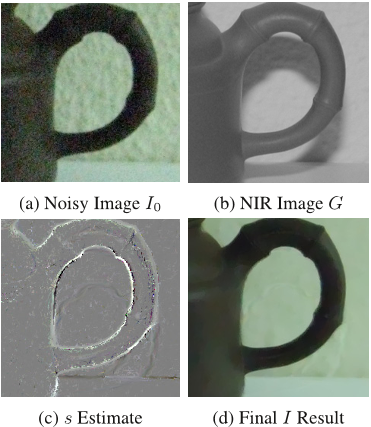




read more










![Figure 8. Comparison with [11]. Whole images are available in our project website.](/figures/figure-8-comparison-with-11-whole-images-are-available-in-2l3xrcgj.png)
because of the popularity of other imaging devices, more computational photography and computer vision solutions based on images captured under different configurations were developed.
To solve the non-convex function E(s, I) defined in Eq. (14), the authors employ the iterative reweighted least squares (IRLS), which make it possible to convert the original problem to a few corresponding linear systems without losing generality.
The authors contrarily propose an iterative method, which finds constraints to shape the s map according to its characteristics and yields the effect to remove intensive noise from input I0.
The restoration result shown in (d) is with much less highlight and shadow, which is impossible to achieve by gradient transfer or joint filtering.
Their estimated s map shown in (c) contains large values along object boundaries, and has close-to-zero values for highlight and shadow.
Since the two input images are color ones under visible light, the authors use each channel from the flash image to guide image restoration in the corresponding channel of the nonflash noisy image.
The authors introduce an auxiliary map s with the same size as G, which is key to their method, to adapt structure of G to that of I∗ – the ground truth noise-free image.
The limitation of their current method is on the situation that the guidance does not exist, corresponding to zero∇G and non-zero ∇I∗ pixels.
This enables a configuration to take an NIR image with less noisy details by dark flash [11] to guide corresponding noisy color image restoration.
Further to avoid the extreme situation when∇xGi or∇yGi is close to zero, and enlist the ability to reject outliers, the authors define their data term asE1(s, I) = ∑i( ρ(|si −pi,x∇xIi|)+ρ(|si−pi,y∇yIi|) ) , (4)where ρ is a robust function defined asρ(x) = |x|α, 0 < α < 1. (5)It is used to remove estimation outliers.
In previous methods, Krishnan et al. [11] used gradients of a dark-flashed image, capturing ultraviolet (UV) and NIR light to guide noise removal in the color image.
The final linear system in the matrix form is((CTx (Px) 2At+1,tx Cx + C T y (Py) 2At+1,ty Cy) + λB t+1,t ) I= (CTx PxA t+1,t x + C T y PyA t+1,t y )s + λBt+1,tI0. (23)The linear system is also solved using PCG and the solution is denoted as I(t+1).